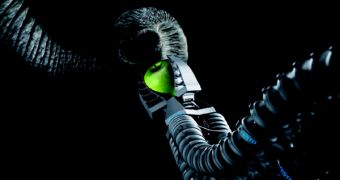Many things and concepts from comic books have caused great fascination or dread over the years, and tentacles seem to have a particular talent for instilling the latter. It didn't stop German designer firm Festo from making some though.
The words “Dynamic Handling Assistants” are not at all indicative of just what Festo has introduced, so we should probably be grateful for how common online videos are.
Without them, we would have easily been lulled into a false sense of security when reading about the latest creation of the company.
Fortunately, a video of the “Dynamic Handling Assistants” does exist, and shows the tentacles in all their wriggly glory.
They look exactly like the tentacle arms of Doctor Otto Octavius from Spiderman, the one that took the name Doctor Octopus, or Doc Ock, after an accident fused the arms to his spine.
Fortunately, the tentacle arms that Festo made are safely ensconced in a testing facility, and are not designed to make any sort of contact with the human nervous system. Indeed, the two arms hang from their respective control platforms.
As you can see in the video, the “Dynamic Handling Assistants” are very flexible, capable of grabbing things and moving them about.
Of course, being likened to “strangely alive giant alien maggots” probably isn't doing anything good for their image, but the description fits.
The arms have artificial intelligence, which means they can actually learn motions, from simple to increasingly complex.
The process is called goal babbling, and is the same (more or less) as how a baby learns to do things: through trial and error. Each time the alien maggots try to grab something and fail, the AI makes small adjustments to the grip and trajectory of the three-pronged claw.
From what we can see in the film and photos, the arms can pick up an apple without crushing it to mush, so that's something at least. It means they can be gentle if needed.
3D printing technology was used to create the individual segments making up the trunks of the two handling assistants.
That means that if the idea catches on with, say, builders and search and rescue vehicles (the arms should actually be able to lift heavy things, if made properly), it won't take too much time or money to make more of these tentacle arms, since no special equipment and factory production lines will need to be created for them.

 14 DAY TRIAL //
14 DAY TRIAL //